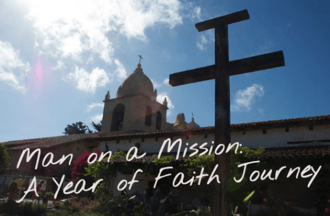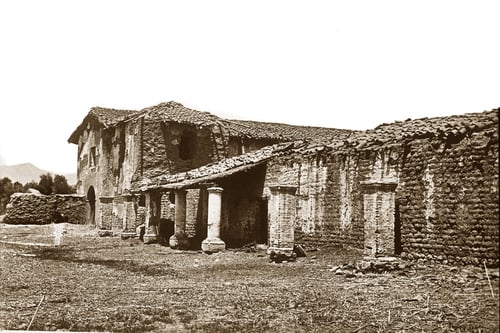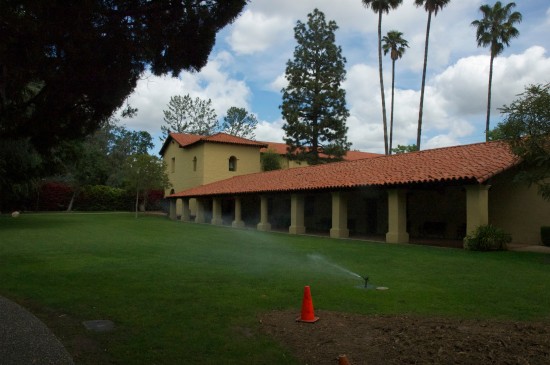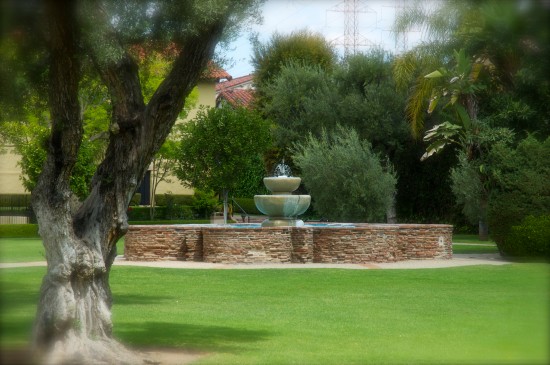On a sunny morning in early April, we were descending into the Los Angeles basin on Interstate 5. We had tickets for a concert in Orange County and planned to spend the night before heading home.
This was the perfect opportunity to visit the two Missions in the Los Angeles area. One on the way down, one on the way back. Our stop on the way down was the Mission San Fernando Rey de Espana, named for Saint Fernando, King of Spain, one of the handful of saints that were also monarchs. That had to be quite the balancing act!
The Mission is at the northern tip of the San Fernando Valley in Mission Hills halfway between Interstates 5 and 405. Exiting the freeway, you pass 1990’s strip malls then cruise through a neighborhood of homes built in the 50’s and 60’s. After passing a large power station, you make a right hand turn into the parking lot and find yourself in the late eighteenth century. Well, not exactly.
The first thing we noticed was that for a mission, things seemed rather new. Unlike the handful of missions we had previously visited, Mission San Fernando has manicured lawns, aggregate walkways, modern drinking fountains and cast iron park benches. The place feels more like a county park than a mission. Rustic it is not. Looking at the church and the long building, we noticed plaster that was smooth and uniform in color, the walls are straight and true. On first impression, Mission San Fernando seems more of a re-creation than a restoration.
There is good reason for this. As we learned in our tour, the Mission was a complete ruin at the turn of the 20th century, it was restored in the 1930’s and 40’s only to be destroyed yet again in the 1971 Sylmar earthquake.
The result is initially disappointing. From the outside, you would have thought that the buildings date back only to 1930's.
The Mission's interior is a different story. Where possible, interior spaces have been nicely preserved, the museum is well curated and the sanctuary has been beautifully restored.
The mission is a classic southern California experience. The old and rustic has been paved over, rebuilt, and landscaped. Yet somehow the beauty of old shines through.
And what is Southern California if not a haven for celebrities? Mission San Fernando's paywall includes the memorial garden and graves of Bob Hope, his wife Dolores and their family. Landscaped in the style of an English rose garden, the memorial feels slightly out of place. Since it is situated behind the mission church, thus not visible from the rest of the mission grounds, the contrast is not jarring. The memorial provides visitors with an additional experience that is interesting in its own right. The garden blends in with the Mission Hills Catholic Cemetery that lies just beyond.
We left Mission San Fernando with a variety of impressions. Under the Franciscans, the mission had been a thriving community . Having fallen into ruin after the mission was secularized in the mid 19th century and re-built at least twice in the 20th, today's mission serves quite a different function than its founders would have ever imagined. Land that was once home to over 1000 settlers, livestock and acres of fruits,grains and vegetables now houses the chancery office for the Archdiocese of Los Angeles, a large Catholic cemetery and a high school.
Through all this change, the Mission San Fernando de Espana is still a church. Whether serving its parishioners in Mission Hills or inspiring the thousands who visit each year, the mission continues to do what it was intended to do. Bring God's message to the new world.
View additional information on Mission San Fernando at missionimage.blogspot.com
Copyright 2013 Kirk Whitney
About the Author

Guest
We welcome guest contributors who graciously volunteer their writing for our readers. Please support our guest writers by visiting their sites, purchasing their work, and leaving comments to thank them for sharing their gifts here on CatholicMom.com. To inquire about serving as a guest contributor, contact editor@CatholicMom.com.






.png?width=1806&height=731&name=CatholicMom_hcfm_logo1_pos_871c_2728c%20(002).png)
Comments